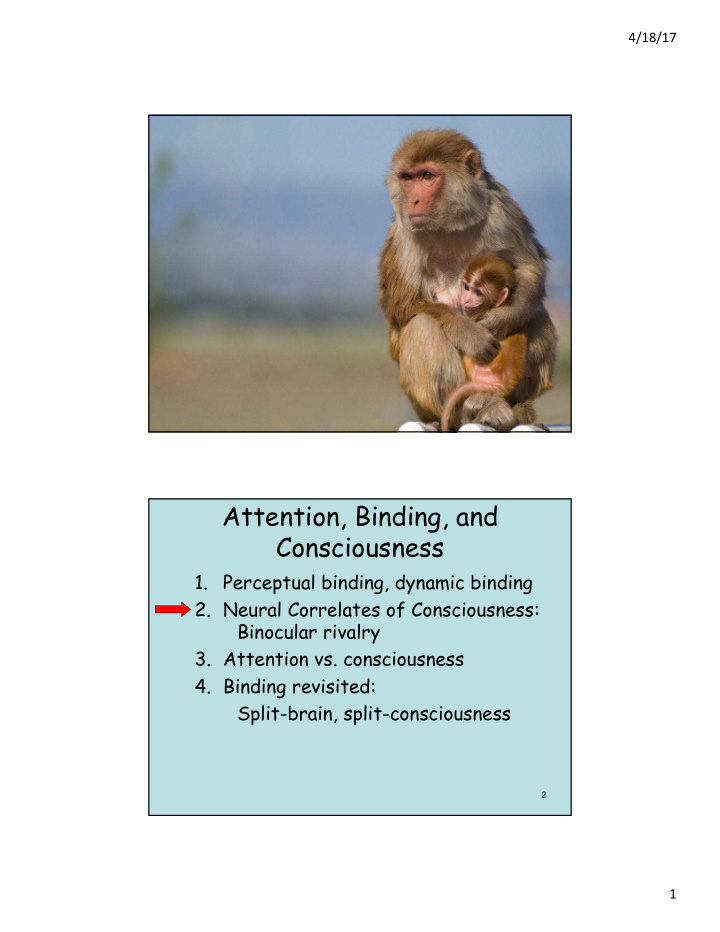



4/18/17 Attention, Binding, and Consciousness 1. Perceptual binding, dynamic binding 2. Neural Correlates of Consciousness: Binocular rivalry 3. Attention vs. consciousness 4. Binding revisited: Split-brain, split-consciousness 2 1
4/18/17 Attention conclusions • Attention enhances detection and reaction times • Spatial or feature attention can turn up the firing rates of relevant neurons or their synchronization • Top-down attention (search) engages frontal areas first, and emphasizes synchronization at lower frequencies (22-34 Hz) • Bottom-up attention (pop-out) engages posterior parietal cortex first, and emphasizes synchronization at higher frequencies (35-55 Hz) Neural Correlates of Consciousness (NCC) The minimal neural activity sufficient for any one specific conscious percept. 4 2
4/18/17 6 3
4/18/17 Binocular rivalry: “follow the percept” Inferior temporal (IT) cortex neurons Sheinberg & Logothetis 1997 Inferior Temporal cortex 7 Superior temporal sulcus (STS) neuron 8 4
4/18/17 STS 9 NCC Conclusions so far • Most cells in higher visual areas (STS, IT) “follow the percept” during rivalry, fewer in lower areas (V4, MT, V1/V2), suggesting that the NCC is not in V1. 10 5
4/18/17 11 Dynamic binding by neural synchronization? “By momentarily synchronizing the fast oscillations generated by different regions of cortex, perhaps the brain binds together various neural components into a single perceptual construction . The evidence for this idea is indirect, far from proven, and understandably controversial.” —Bear p.592 12 6
4/18/17 13 Gamma synchrony is organized by theta rhythm before stable percept onsets 14 7
4/18/17 More NCC Conclusions • Most cells in higher visual areas (STS, IT) “follow the percept” during rivalry, fewer in lower areas (V4, MT, V1/V2), suggesting that the NCC is not in V1. • Conscious perception may also correspond to bursts of gamma synchronized neural activity organized by theta rhythms 15 Attention, Binding, and Consciousness 1. Perceptual binding, dynamic binding 2. Neural Correlates of Consciousness: Binocular rivalry 3. Attention vs. consciousness 4. Binding revisited: Split-brain, split-consciousness 16 8
4/18/17 17 18 9
4/18/17 19 20 10
4/18/17 Attention and awareness recruit different oscillation frequencies 21 Neural Synchrony Conclusions 1. Attention and awareness (and dreaming) are all associated with increased synchronization of gamma oscillations 2. Distinct processes recruit distinct areas and frequencies 3. à “A fundamental mechanism engaged whenever neural cooperativity is required.” 22 11
4/18/17 Attention, Binding, and Consciousness 1. Perceptual binding, dynamic binding 2. Neural Correlates of Consciousness: Binocular rivalry 3. Attention vs. consciousness 4. Binding revisited: Split-brain, split-consciousness 23 A single integrated whole: the intrinsic unity of conscious experience 12
4/18/17 WHAT UNITY OF CONSCIOUSNESS? Mike Gazzaniga 1967 13
4/18/17 Communicating with a single hemisphere “…let not thy left hand know what thy right hand doeth.” Matthew 6:3 14
4/18/17 Multitasking: splitting the attentional bottleneck Inter-hemispheric interference 15
4/18/17 Serial search — in parallel! SPLIT-BRAIN < 700 ms WHOLE-BRAIN ~ 700 ms The left- hemisphere interpreter establishes a running narrative and self -concept 16
4/18/17 Hemispheric specialization Left is better at Right is better at • Speaking, language • Pattern matching • Problem solving, planning, • Face recognition intelligence • Perceptual grouping/illusory • Interpretation, contours hypothesizing, story- • Dual tasks making, confabulation • 3D drawing • Voluntary smiling, top-down • Being veridical attention • Global attention Conclusions from split-brain studies • Although the right hemisphere has very limited verbal abilities, surgically separating the hemispheres appear to result in two independent consciousnesses , one in each hemisphere: split-brain, split consciousness. • This result does not conflict with the observation or claim that consciousness is an intrinsically unified state 34 17
Recommend
More recommend